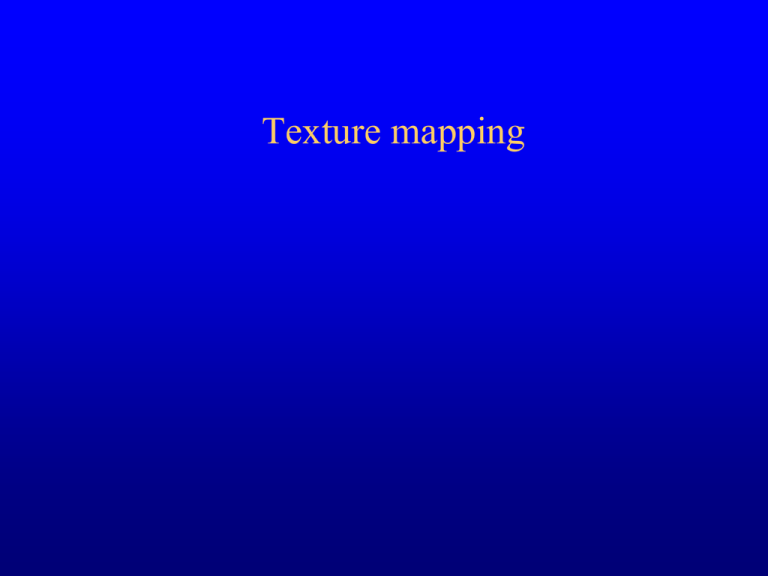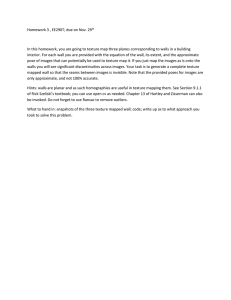Texture mapping
advertisement

Texture mapping Texture Visual appearance of a real world surface Texture mapping Adding texture detail to a modeled surface Describing textures Fixed view/illumination 2D texture maps Varying view/illumination Multiple 2D texture maps Why Texture Map Adds photorealism to 3D models Can assist in scan registration Can recover shape detail at higher resolution than range scans History – 1970’s – 1980’s 1970’s – 1974 – Original concept presented [Catmull 74] – 1976 – Reflection maps [Blinn and Newell 76] – 1978 – Bump mapping [Blinn 78] 1980’s – – – – – 1983 – Texture mapping polygons in perspective [Heckbert 83] 1983 – Filtering for antialiasing [Williams 83] 1984 – Illumination mapping [Miller and Hoffman 84] 1986 – Environment maps [Greene 1986] 1986 – Survey of texture mapping [Heckbert 1986] History 1990’s 1990’s – – – – 1991: Interpolation for polygon texture mapping [Heckbert 91] 1992: Projective texture mapping [Segal 92] 1992: SGI RealityEngine – Hardware texture mapping 1996: View dependent texture mapping [Debevec et. 96] Texture-modulated Quantities • Modulation of object surface properties • Reflectance – Color (RGB), diffuse reflection coefficient kd – Specular reflection coefficient ks • Opacity (α) • Normal vector – N(P)= N(P+ t N) or N= N+dN – Bump mapping or Normal mapping • Geometry – P= P + dP: Displacement mapping • Distant illumination – Environment mapping, Reflection mapping“ Using photographs as textures Viewpoint 3D model Photogrammetry, Range scan, Maya (CAD) Texture registration Visibility Reconstruct & Render Hidden surface removal [Debevec et al. 96, 98] [Pulli et al. 97] [Buehler et al. 01] Mechanisms of Reflection source incident direction body reflection • Body Reflection: Diffuse Reflection Matte Appearance Non-Homogeneous Medium Clay, paper, etc surface reflection surface • Surface Reflection: Specular Reflection Glossy Appearance Highlights Dominant for Metals Image Intensity = Body Reflection + Surface Reflection Rendering under novel illumination BRDFs: 3D model Bidirectional Reflection Distribution Function Viewpoint Lighting model Lo (x, o ) ( x, i , o )Li ( x, i )( n (x ) i )di Diffuse Reflection and Lambertian BRDF source intensity I incident direction normal s n i viewing direction v surface element • Surface appears equally bright from ALL directions! (independent of ) albedo v f ( i , i ; r , r ) • Lambertian BRDF is simply a constant : • Surface Radiance : d L I cos i • Commonly used in Vision and Graphics! d I n.s source intensity d Diffuse Reflection and Lambertian BRDF Reflections [Blinn 76] Reflection maps. – Used to model an object that reflects its surroundings to the eye – Texture: environment (sphere, latitude/longitude map, cube) – For each surface point, compute the polar coordinates of the reflected area with respect to the current viewpoint. – Use those coordinates to map a 2D environment map. – Filter accordingly Environment map Teapot with highlights Blinn and Newel 1976. Texture and reflections in computer generated Bump mapping Shade based technique. – Displacement map – Compute a new normal for each point P + Blinn 1978 Simulation of wrinkled surfaces = Visibility processing Solved problem Reference images Eye Very well studied problem in CG: hidden surface removal – z-buffer, back-face culling, painter’s algorithm, ray-casting – [Debevec 96, 98] z-buffer solution, [98] with polygon clipping and object space testing (if required) – [Rocchini 99] Ray casting approach accelerated with uniform grids The mapping process Mapping function 1D/2D/3D image Texture space (u,v,w) Modeling + Projection 3D surface Object space (x,y,z) Screen space (s,t) Affine (bricks) Projective (Shadow map, Real scenes) Forward P. Heckbert 1986. Survey of Texture Mapping Inverse Surface parameterization Bi-quadratic Perspective Affine Surface parameterization How do we fill the interior? Texture-object : affine Object-screen : projective Compound mapping :projective P. Heckbert 1986. Survey of Texture Mapping Texture-object : projective Object-screen : projective Compound mapping :projective Segal 1992. Fast shadows and lightning effects Texture aliasing A screen pixel may map to several texels – Point sampling a high-frequency texture can cause aliasing Aliasing caused by point sampling The solution is to filter (avg) the texels at the cost of: Expensive texel averaging that can reduce rendering rates Smoothing Reduce cost by prefiltering Filter shape What is a pixel ? A box, a rectangle, a circle? P. Heckbert 1986. Survey of Texture Mapping Filtering using pyramids Reduce the cost of filtering by creating a pyramid of pre-filtered images. – Mip map: Each pyramid level contains a 2n sized version of the image. – Trilinear Interpolation is done across different levels of the pyramid. Total cost is constant. – Supported by today’s graphics hardware and APIs (OpenGL) Lance Williams 1983 Pyramidal Parametrics Filter comparison Point sampling Summed area tables P. Heckbert 1986. Survey of Texture Mapping Trilinear interpolation on a pyramid Elliptical Weighted Average Texture registration Camera calibration problem (very well studied) – Find extrinsic (required) and intrinsic parameters (if not known) – Good calibration important to avoid artifacts! Feature match – Points, lines, other geometric feature – Manual, automatic No calibration req. Manual Automatic Same camera used for range and color images [Pulli 97] Line matching [Debevec 96] Rectangle matching [Stamos 01] Point matching [Rocchini 01] Silhouette [Lensch 00] Texture reconstruction Reference images Eye Each reference image usually contributes to the final result Texture reconstruction - summary Problem: how to find optimal weights for each camera Solutions proposed mostly consider viewpoint dependence – Good for surfaces that are facing the camera. – Good to capture specular highlights and other viewpoint dependent effects – Not so good for surfaces at grazing angles where texture sampling density decreases What about non-view dependent texture mapping? Best solution: domain and application specific. Weighted average View weight Resolution weight FOV weight N Reference image Normal weight Eye [Debevec 96] [Debevec 98] [Pulli 97] [Buehler 01] View weight X X X X Normal weight Field of view weight X X X X Resolution X Acquiring, Stitching and Blending Diffuse Appearance Attributes on 3D Models C. Rocchini, P. Cignoni, C. Montani, R. Scopigno Istituto Scienza e Tecnologia dell’Informazione Synthetic images of our vase rendered a without color, b with a naive mapping of the color textures acquired by a commercial laser scanner and c with our unshaded, locally registered and cross-faded textures [Rocchini et al. 01] Acquiring diffuse surface attributes Create an albedo map Enforce Lambertian surface assumption by removing shadows and specular highlights Photometric Stereo Lambertian case: I n s1 • s2 kc kc cos i n s 1 Image irradiance: s3 v I1 n s1 I 2 n s 2 I 3 n s 3 We can write this in matrix form: T s1 I1 I sT n 2 2 sT3 I 2 Acquisition of Surface Attributes define viewpoints capture multiple images from each viewpoint differ lighting between images Un-shading of Images want illumination-invariant colors, not light direction dependent colors remove main shading effects – – – – direct shading cast shadows specular highlights but not inter-object reflections Un-shading of Images before un-shading after un-shading Fig. 6a–b1. An example of two valid images, (a) and (b); if we map image (b) on the mesh and render a synthetic image (b1) using the same viewpoint of image (a), then we can see how poor and distorted the detail is in the right-most side of the mesh; obviously, mapping image (a) on this mesh section can give a much better local representation of the detail Fig. 7a,b. Iterative local optimization of texture coverage: in the sample drawing, vertices are initially assigned to three target images (represented by a hexagon, a square and a circle). Then, we select a set of frontier vertices (indicated by arrows) and change their target images, obtaining configuration (b), which now corresponds to a local minimum. Frontier faces areindicated with an “F ” in (b) Fig. 8. An example of optimized frontier face management. Left: we have 1137 frontier faces out of a total of 10 600 in the initial configuration; right: we have only 790 frontier faces after optimization equal to the projection of its vertices on ik – this face is called internal; • if, conversely, the vertices of f are linked to two (or even three) different target images, then face f is 40cm tall ceramic vase complex painted surface 8 views required running time of ~89sec Three different views of the resulting vase mesh (rendered without shading using a standard OpenGLbased interactive renderer). The image on the bottom is a re-lighted image, obtained with a photorealistic rendering software Results ~25cm tall statuette – complex shape – 14 views required – running time of ~62sec




